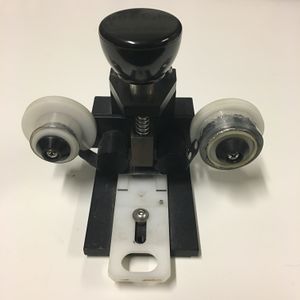| Welcome to Sprocket School! This project is maintained by volunteer editors. Learn more about how this works. |
Foil cues: Difference between revisions
No edit summary |
No edit summary |
||
| Line 17: | Line 17: | ||
* Turn the lamphouse on or off | * Turn the lamphouse on or off | ||
Cue proximity detectors were programmed to detect [[inboard]] foil cues, [[outboard]] foil cues, and crossframe foil cues. Several manufacturers produced foil cue readers, and many multiplex managers customized the technology to fit their specific needs. As foil cue position and function were never standardized for all theaters, they could not be applied in advance by the [[laboratory]], [[distributor]], or [[exchange]] manager. Foil cues were always applied by the projectionist with an eye towards the venue's specific needs, often during the print inspection and make-up process. | Cue proximity detectors were programmed to detect [[Film orientation#Inboard|inboard]] foil cues, [[outboard]] foil cues, and crossframe foil cues. Several manufacturers produced foil cue readers, and many multiplex managers customized the technology to fit their specific needs. As foil cue position and function were never standardized for all theaters, they could not be applied in advance by the [[laboratory]], [[distributor]], or [[exchange]] manager. Foil cues were always applied by the projectionist with an eye towards the venue's specific needs, often during the print inspection and make-up process. | ||
Consequently, an inboard foil cue could trigger a change-over on one system while triggering an auditorium lighting change on another. Best practices dictated that a projectionist remove cues from a print at the conclusion of its run; otherwise, the existing cues could inadvertently trigger undesired automation at the next venue. | Consequently, an inboard foil cue could trigger a change-over on one system while triggering an auditorium lighting change on another. Best practices dictated that a projectionist remove cues from a print at the conclusion of its run; otherwise, the existing cues could inadvertently trigger undesired automation at the next venue. | ||
Revision as of 13:17, 29 October 2025



Foil cues are short strips of adhesive foil attached to the edge of a projection print. They are used to facilitate auditorium and projection booth automation, and were historically common in a multiplex setting. Today their primary use is in museum and gallery settings, where they may be used as part of a semi-automated film installation.
When using foil cues, a proximity cue detector is embedded somewhere in the projector's normal thread path; when the foil cue passes through the proximity cue detector, the circuitry closes the appropriate relay and triggers the desired automated function.
Foil cues were widely used during the multiplex era, but are rarely used in theatrical settings today. They are not considered compatible with archival best practices.
Functionality
Historically, foil cues were used to trigger many common projectionist tasks, including, but not limited to:
- Raising or lowering auditorium lights
- Opening or closing the projector dowser
- Activating the projector changeover function
- Turn the lamphouse on or off
Cue proximity detectors were programmed to detect inboard foil cues, outboard foil cues, and crossframe foil cues. Several manufacturers produced foil cue readers, and many multiplex managers customized the technology to fit their specific needs. As foil cue position and function were never standardized for all theaters, they could not be applied in advance by the laboratory, distributor, or exchange manager. Foil cues were always applied by the projectionist with an eye towards the venue's specific needs, often during the print inspection and make-up process.
Consequently, an inboard foil cue could trigger a change-over on one system while triggering an auditorium lighting change on another. Best practices dictated that a projectionist remove cues from a print at the conclusion of its run; otherwise, the existing cues could inadvertently trigger undesired automation at the next venue.
Archival Implications
Foil cues were used to facilitated a level of projection booth automation that is incompatible with archival best practices. As archival booths are expected to use a two-projector changeover system and be staffed at all times, automation is neither necessary nor desired in a theatrical setting.
Stray foil cues will not trigger inadvertent automation functionality unless a cue proximity detector has been installed. Nevertheless, archive vault staff will often remove leftover foil cues because they are viewed as a print contaminant. Older foil cues can sometimes leak adhesive, which tends to attract dirt and dust. Some foil cues will be quite easy to remove, while older cues may be more difficult as well as leave residue behind.
Foil cues are still acceptable in museum or gallery settings where their use may be considered part of a work of art or where there is a budget to pay a film lab to print new copies of the film on display.
For cues that fit within a single frame, clear splicing tape may be applied beneath the cue to facilitate removal. The cue can then be removed by peeling the splicing tape off from the edge of the film, reducing unnecessary handling of the picture area and preventing the cue's adhesive from leaving a mark on the film.